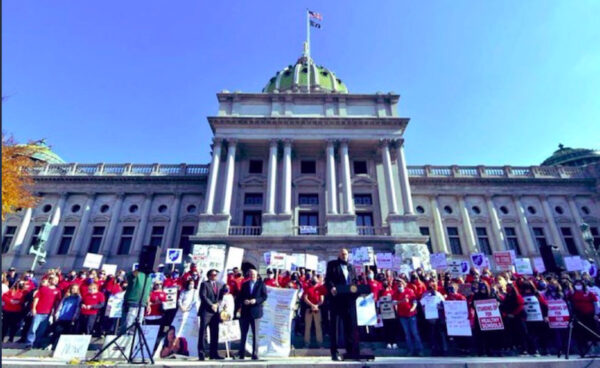
SCRANTON, Pa.—Members of the Scranton Federation of Teachers approved a six-year contract agreement on Nov. 23, ending a strike that began Nov. 3. The union described the vote as “overwhelming.”
The deal, announced Nov. 19, will run through the 2022-23 school year. It will raise teachers’ starting salaries, which are among the lowest in the state of Pennsylvania, from $38,377 a year to roughly $41,700, and will also give some retroactive pay and step increases for the more than four years teachers and paraprofessionals worked without a contract.
“They were relieved,” SFT President Rosemary Boland told LaborPress. The Scranton Board of Education is scheduled to vote on the agreement during a special meeting on Nov. 30.
The union and the Scranton School District reached agreement on pay relatively quickly, Boland says, as low salaries have made it hard to attract and retain teachers and paraprofessionals. The one hitch was that the district at first refused to use federal and state stimulus funds to cover retroactive pay from before the COVID-19 pandemic hit in early 2020.
Health care and scheduling were more contentious, though. The district wanted to switch educators’ health care to a system called “reference-based pricing,” in which it would hire a private plan that cuts deals with doctors, labs, clinics, and hospitals to pay them a set rate for specific services, and if the provider was not in the network and charged more, it would send the patient a bill for the balance.
“We wanted nothing to do with that,” Boland says. In the end, the union agreed to keep traditional health coverage, but with a narrower network of providers who take it.
Rising costs will remain a problem until “the country figures out how to deal with health care,” she adds.
The district also demanded that teachers take on a sixth period of classes, cover absent teachers’ classes for no extra pay, and come in 15 minutes earlier and leave 15 minutes later.
The SFT objected to the sixth period, as it would have enabled the district to eliminate 82 teachers’ jobs. It agreed to it, though, under the condition that the increased workload cannot be used as a reason to furlough teachers — effectively, a limit on how many will have to teach a sixth class.
“That was really important to us,” says Boland.
The number of teachers required to cover classes will be limited to the 14 most recently hired, and they will be relieved of that obligation when newer teachers are hired.
No one objected to the extra 30 minutes, Boland says, as most teachers already come in early and stay late.
American Federation of Teachers President Randi Weingarten, who aided the Scranton local in at the bargaining table and spoke at union rallies, praised the strikers for a victory over “austerity,” and parents for supporting teachers and paraprofessionals.
“The powers that be kept saying just do more with less,” she said in a statement. “The professionals who teach and support children had been underpaid and constantly relied upon to always make up for harmful cuts to programs. This contract changes course.”
Boland avers that district negotiators could have averted the strike if they’d bargained in good faith. “We could have gotten this done five years ago,” she says.
When the union negotiates a contract, she explains, “I think we’re sitting down as equals to work through the issues… but when one side decides not to do that, that’s when everything blows up. That’s what happened in Scranton.”
The deeper problem, Boland says, is that the Scranton district is underfunded by $39 million a year, almost $400 per pupil. In 2019, the state put the district on “financial recovery” status, with strict limits on its budget.
“This all could have been avoided if there was an equitable state formula for public education funding,” AFT Pennsylvania President Arthur Steinberg said in a statement. “A victory in the current fair funding trial in Philadelphia is essential.”
A lawsuit arguing that Pennsylvania’s school-funding formula is so inequitable that it violates the state constitution’s mandate for a “thorough and efficient system of education” is now being heard in Philadelphia. The state created a revised “Fair Funding” formula in 2016 that increased aid to districts with low-income students, but the lawsuit contends that it did little to close the gap between affluent districts with high property-tax revenues and aging industrial cities with shrunken tax bases, like Scranton.
“There’s nothing fair about it now,” says Boland. “It’s very important to districts like ours to boost funding. It has to be made fair.”




1 thought on “Scranton Teachers Strike Ends with New Six-Year Contract”
Teachers will have to teach six classes a day, and that’s a victory?